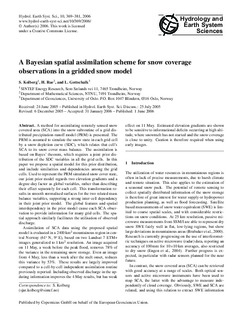| dc.description.abstract | A method for assimilating remotely sensed snow
covered area (SCA) into the snow subroutine of a grid distributed
precipitation-runoff model (PRM) is presented. The
PRM is assumed to simulate the snow state in each grid cell
by a snow depletion curve (SDC), which relates that cell’s
SCA to its snow cover mass balance. The assimilation is
based on Bayes’ theorem, which requires a joint prior distribution
of the SDC variables in all the grid cells. In this
paper we propose a spatial model for this prior distribution,
and include similarities and dependencies among the grid
cells. Used to represent the PRM simulated snow cover state,
our joint prior model regards two elevation gradients and a
degree-day factor as global variables, rather than describing
their effect separately for each cell. This transformation results
in smooth normalised surfaces for the two related mass
balance variables, supporting a strong inter-cell dependency
in their joint prior model. The global features and spatial
interdependency in the prior model cause each SCA observation
to provide information for many grid cells. The spatial
approach similarly facilitates the utilisation of observed
discharge.
Assimilation of SCA data using the proposed spatial
model is evaluated in a 2400 km2 mountainous region in central
Norway (61 N, 9 E), based on two Landsat 7 ETM+
images generalized to 1 km2 resolution. An image acquired
on 11 May, a week before the peak flood, removes 78% of
the variance in the remaining snow storage. Even an image
from 4 May, less than a week after the melt onset, reduces
this variance by 53%. These results are largely improved
compared to a cell-by-cell independent assimilation routine
previously reported. Including observed discharge in the updating
information improves the 4 May results, but has weak effect on 11 May. Estimated elevation gradients are shown
to be sensitive to informational deficits occurring at high altitude,
where snowmelt has not started and the snow coverage
is close to unity. Caution is therefore required when using
early images. | nb_NO |
